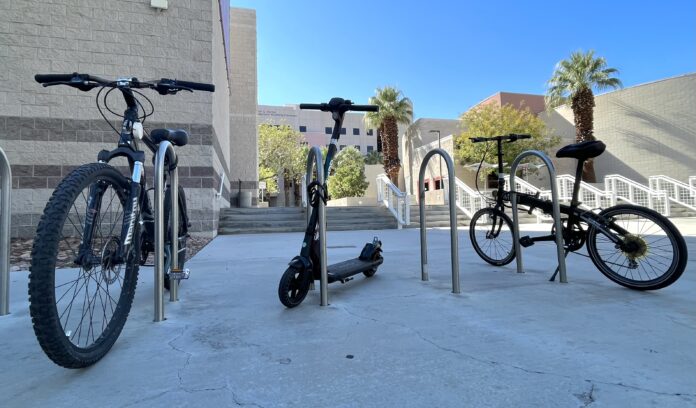
As college students look for ways to manage their demanding schedules, many opt for electric scooters to cut the time it takes to get to and from class. This convenience is not without risk. The dangers associated with motorized scooters require everyone to be alert and take action to keep campus safe.
“Whenever you mix pedestrians and moving objects, moving people, you always have a risk of collision,” said John Tomola, UNLV’s Occupational Safety Program Manager. “It’s not necessarily a hazard per se, but there is a risk of collision, and from those collisions, you could have resulting injuries,” he continued.
When asked about the frequency of incidents involving scooters on campus, Tomola said, “There have been cases where it’s been reported, which are probably far fewer than the total number of instances that have occurred, because quite often those may not be reported.”
Penny, a scooter rider who claimed her scooter saves her “lots of time,” recalled an incident she experienced. “I got hit by a car,” she said, as she gestured to a crosswalk a few meters away. “I got up and went to class because I could not miss this class. Didn’t suffer anything serious, just my wrist started hurting, and then my waist started to hurt, because I had just slammed into the concrete,” she added.
Penny did not report the collision. “I didn’t know how to,” she said. “At the moment, I felt fine.” The convenience of her scooter did not stop her from seeing the risks. ”During crowded times, I do see the danger of it, ‘cause there’s a lot of students going to class. I’ve never seen anyone hit people, but I’ve seen close calls,” she said.
Students and officials are aware of the risks that come with electric scooters, but there are not many rules in place by UNLV to regulate them on campus. The University Police Department FAQ states that motorized scooters are allowed on campus “except where signage is posted indicating it is prohibited.” Additionally, “scooters designed to be ridden on the road are prohibited from use within campuses.”
Tod Miller, Assistant Chief of University Police Services, explained how Nevada state law governs these vehicles. “When it comes to pedestrian safety, anytime there are vehicles, bicycles, electric bicycles/scooters or other motorized vehicles in close proximity to pedestrians or sharing the same pathways, there is an increased risk of accidents,” he said. “Generally speaking, electric scooters must follow the same standards as bicycles and electric bicycle operations. State law that governs is located in Nevada Revised Statutes (NRS) 484B.760-484B790,” he said.
These statutes outline the responsibilities of riders. For example, riders must be aware of where they are going and able to come to a controlled stop. They must be visible at night through the use of lights and reflective material, and they must have at least one hand on the handlebars at all times. The law leaves room for local authorities to adopt their own rules to regulate electric scooters. It may be time for UNLV to do so.
“What I’ve been a proponent of is a travel lane for scooters and skateboards and bicyclists,” Tomola said. He explained discussions of a wheel conveyance policy on campus. “The purpose of that is to help spell out responsibilities and help individuals realize the need to work with each other to keep it safe and sane out there,” he said.
In a memorandum Tomola wrote on the subject in September of last year, he defined a wheeled conveyance as anything ridden or driven on campus except for “golf/utility carts, motorized vehicles and electric personal assistive mobility devices.” This memo provided a draft of a policy proposal which outlined the need for travel lanes and restricted areas where wheeled conveyances would not be allowed. If passed, this policy would prohibit the use of electric scooters on or inside of buildings, entrances, exits, ramps or stairways. This policy is only a draft, and it has not been approved by university officials.
“We’re not proposing a ban on anything that’s being driven out there,” Tomola said. “It’s not the goal or mission to bar or ban people who are riding wheeled conveyances and electric bikes and scooters on campus but rather to try and regulate between the two.”
“Our hope for that is to make sure that it’s a good environment for both those who operate those as well as pedestrians, and to make sure that, y’know, it relies on courtesy and respect,” he said.
The responsibility is on riders to keep themselves and others safe. “Helmets and any type of protective gear would be well worth it, as well as a realization of the weather conditions out there and how those affect scooters and bicycle operations,” Tomola added.
Motorized scooters pose significant safety risks to riders and pedestrians on school campuses. UNLV does not currently have a policy to regulate the use of these devices, and it is up to users to be aware of the risks they may face on their daily commute. To report a safety concern or near miss on campus, fill out the report form on UNLV Risk Management and Safety’s website, or visit their office at CSB 201.
